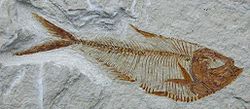
Diplomystus
Encyclopedia


Clupeidae
Clupeidae is the family of the herrings, shads, sardines, hilsa and menhadens. It includes many of the most important food fishes in the world.-Description and biology:...
clupeomorph
Clupeiformes
Clupeiformes is the order of ray-finned fish that includes the herring family, Clupeidae, and the anchovy family, Engraulidae. The group includes many of the most important food fish....
fish distantly related to modern-day extant herrings, alewives, and sardines. The genus was first named and described by Edward Drinker Cope
Edward Drinker Cope
Edward Drinker Cope was an American paleontologist and comparative anatomist, as well as a noted herpetologist and ichthyologist. Born to a wealthy Quaker family, Cope distinguished himself as a child prodigy interested in science; he published his first scientific paper at the age of nineteen...
in 1877. There are four species of Diplomystus: Diplomystus dentatus (Cope, 1877), D. birdii, D. dubetreiti, and D. shengliensis (Chang 1983).
Diplomystus dentatus (Cope, 1877) is well known from lower Eocene deposits of the Green River Formation
Green River Formation
The Green River Formation is an Eocene geologic formation that records the sedimentation in a group of intermountain lakes. The sediments are deposited in very fine layers, a dark layer during the growing season and a light-hue inorganic layer in winter. Each pair of layers is called a varve and...
in Wyoming. Specimens range from larval size to 65 cm and are commonly found in close association with the extinct herring Knightia
Knightia
Knightia is an extinct genus of bony fish which lived in the fresh water lakes and rivers of North America during the Eocene epoch. It was named by David Starr Jordan in 1907, in honor of the late University of Wyoming professor Wilbur Clinton Knight, "an indefatigable student of the paleontology...
sp.

